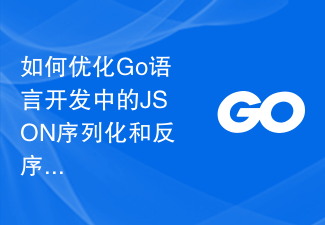 Backend Development
Backend Development Golang
Golang Variables and pointers in Go language: differences and importance in memory management
Variables and pointers in Go language: differences and importance in memory management
The difference between variables and pointers in Go language and their role in memory management
In Go language, variables and pointers are different concepts, they represent respectively Different ways to store and use. This article will introduce in detail the difference between variables and pointers in the Go language and discuss their role in memory management.
1. The concepts and differences between variables and pointers
A variable is a section of memory space used to store data, which is identified and referenced by the variable name. In Go language, variables are declared as var variable name type. For example, var num int means declaring a variable num of type int.
The pointer is a variable pointing to the memory address of the variable. Through pointers, we can directly read or modify the value in the corresponding memory address. The declaration method of pointer type is var pointer name type. For example, var ptr int indicates that a pointer ptr of type int is declared.
The difference between variables and pointers can be summarized as follows:
- Variables store the value of data, while pointers store the memory address of the variable;
- Variables can Directly access and modify data, while pointers need to access and modify data through dereference operations (*ptr);
- Variables will be initialized to the zero value of their type when they are defined, while pointers will be initialized when they are defined. Initialized to nil.
2. The role of variables and pointers in memory management
In the Go language, variables and pointers play an important role in memory management.
- The role of variables in memory management
The existence of variables can facilitate us to operate data, such as assignment, calculation, etc. At the same time, when a function is called, variables can be passed to the function as parameters, and function operations can be performed by copying the variables.
The following is a sample code that demonstrates the use of variables:
package main
import "fmt"
func main() {
var num int = 10
fmt.Println("初始值:", num)
modifyValue(num)
fmt.Println("修改后的值:", num)
}
func modifyValue(val int) {
val = 20
}The running result is:
初始值: 10 修改后的值: 10
You can see that the variable val is modified in the function modifyValue The assignment operation will not affect the value of the original variable num. This is because the parameter val in the function is a copy of num, and modifying its value will not affect the original variable.
- The role of pointers in memory management
Pointers can allow us to directly access and modify the value in the memory address of a variable, thus playing a key role in memory management.
The following is a sample code that demonstrates the use of pointers:
package main
import "fmt"
func main() {
var num int = 10
var ptr *int
ptr = &num
fmt.Println("初始值:", num)
modifyValue(ptr)
fmt.Println("修改后的值:", num)
}
func modifyValue(ptr *int) {
*ptr = 20
}The running result is:
初始值: 10 修改后的值: 20
You can see that in the function modifyValue, through the pointer The ptr dereference operation modifies the value of the memory address variable pointed to, thereby indirectly modifying the value of the original variable num.
Through the comparison of sample codes, you can clearly see the different roles of variables and pointers in memory management. Variables provide the ability to access and operate data, while pointers provide the ability to directly operate on variable memory addresses.
Summary:
This article introduces the difference between variables and pointers in Go language and their role in memory management. Variables store the value of data, while pointers store the memory address of the variable. Variables facilitate manipulation and transfer in memory management, while pointers allow direct access and modification of the value in the memory address of the variable. For Go language developers, understanding the difference between variables and pointers and using them appropriately will help write efficient and reliable code.
The above is the detailed content of Variables and pointers in Go language: differences and importance in memory management. For more information, please follow other related articles on the PHP Chinese website!
 如何在Go中使用常量?May 11, 2023 pm 04:52 PM
如何在Go中使用常量?May 11, 2023 pm 04:52 PM在Go中,常量(Constants)是保持固定值的标识符,它们在整个程序执行期间都不会改变。Go中的常量通过const关键字进行声明。在这篇文章中,我们将探讨在Go中如何使用常量。如何声明一个常量在Go中声明常量非常简单,只需要使用const关键字即可。格式如下:constidentifier[type]=value其中,identifier是常量名
 实战经验:Go语言开发项目中的最佳实践Nov 02, 2023 pm 01:07 PM
实战经验:Go语言开发项目中的最佳实践Nov 02, 2023 pm 01:07 PM摘要:本文主要介绍了在Go语言开发项目中的最佳实践。通过讲解项目结构的设计、错误处理、并发处理、性能优化和测试等方面的经验,帮助开发者更好地应对实际项目中的挑战。一、项目结构的设计在开始一个Go语言项目之前,良好的项目结构设计是至关重要的。一个好的项目结构能够提高团队的协作效率,并且能够更好地管理项目的代码和资源。下面是一些项目结构的最佳实践:尽量将代码分离
 如何使用Go语言进行代码并行化实践Aug 02, 2023 am 09:12 AM
如何使用Go语言进行代码并行化实践Aug 02, 2023 am 09:12 AM如何使用Go语言进行代码并行化实践在现代软件开发中,性能是一个非常重要的考量因素。为了提升代码执行效率,我们可以使用并行化的编程技术。Go语言作为一门并发编程语言,拥有丰富的并行化工具和特性,可以帮助我们很好地实现代码的并行化。本文将介绍如何使用Go语言进行代码并行化实践,从基本的并发处理开始,到复杂的并行算法优化。基本并发处理并发处理是指同时执行多个任务,
 如何在Go语言中实现路由分组Dec 17, 2023 pm 11:09 PM
如何在Go语言中实现路由分组Dec 17, 2023 pm 11:09 PMGo语言是一种简洁高效的编程语言,在Web开发领域也有广泛的应用。在Web开发中,路由是必不可少的部分。而路由分组则是一个更加高级的路由功能,它可以使代码更加清晰、简洁,提高代码可读性和可维护性。本文将从原理和代码实现两个方面,详细介绍如何在Go语言中实现路由分组。一、分组的原理路由分组相当于将一些具有相似特点的路由进行分组管理。例如,我们可以将所有的API
 如何优化Go语言开发中的JSON序列化和反序列化Jul 01, 2023 pm 09:01 PM
如何优化Go语言开发中的JSON序列化和反序列化Jul 01, 2023 pm 09:01 PM如何优化Go语言开发中的JSON序列化和反序列化在Go语言开发中,JSON(JavaScriptObjectNotation)是一个经常使用的序列化和反序列化格式。它简洁、可读性强,并且在不同平台之间易于交互。然而,在处理大型数据或者高并发场景下,JSON的序列化和反序列化性能可能成为性能瓶颈。本文将介绍一些优化Go语言开发中的JSON序列化和反序列化的
 解决Go语言Websocket应用程序内存泄漏的方法Dec 14, 2023 pm 01:46 PM
解决Go语言Websocket应用程序内存泄漏的方法Dec 14, 2023 pm 01:46 PM解决Go语言Websocket应用程序内存泄漏的方法,需要具体代码示例Websocket是一种在网络上实现全双工通信的协议,常用于实时的数据传输和推送。在Go语言中,我们可以通过使用标准库net/http中的WebSocket模块来编写Websocket应用程序。然而,在开发Websocket应用程序时,我们可能会遇到内存泄漏的问题,导致应用程序的性能下降甚
 Go 语言中的垃圾回收机制是怎样工作的?Jun 10, 2023 am 08:55 AM
Go 语言中的垃圾回收机制是怎样工作的?Jun 10, 2023 am 08:55 AMGo语言是一个开源的静态类型编程语言,由Google公司开发,于2009年首次亮相。它的特点是语法简单、性能高、并发编程方便等,因此受到了越来越多程序员的喜爱。在Go语言中,一般情况下不需要手动管理内存,因为它提供了垃圾回收机制,可以自动进行内存管理。那么,Go语言中的垃圾回收机制是怎么工作的呢?本篇文章将为大家进行介绍。Go语言中的垃圾回
 如何使用Go语言实现多态性和接口Jul 22, 2023 pm 02:12 PM
如何使用Go语言实现多态性和接口Jul 22, 2023 pm 02:12 PM如何使用Go语言实现多态性和接口在Go语言中,虽然没有类的概念,但我们可以通过接口和多态性来达到类似的效果。本文将介绍如何使用Go语言的接口来实现多态性,并通过代码示例详细说明。接口介绍在Go语言中,接口是一组方法的集合。一个对象只要实现了接口中的方法,就可以被称为该接口的类型。接口定义可以认为是一种契约,实现该接口的对象必须满足接口定义的方法签名。实现接口


Hot AI Tools

Undresser.AI Undress
AI-powered app for creating realistic nude photos

AI Clothes Remover
Online AI tool for removing clothes from photos.

Undress AI Tool
Undress images for free

Clothoff.io
AI clothes remover

AI Hentai Generator
Generate AI Hentai for free.

Hot Article

Hot Tools

VSCode Windows 64-bit Download
A free and powerful IDE editor launched by Microsoft

WebStorm Mac version
Useful JavaScript development tools

DVWA
Damn Vulnerable Web App (DVWA) is a PHP/MySQL web application that is very vulnerable. Its main goals are to be an aid for security professionals to test their skills and tools in a legal environment, to help web developers better understand the process of securing web applications, and to help teachers/students teach/learn in a classroom environment Web application security. The goal of DVWA is to practice some of the most common web vulnerabilities through a simple and straightforward interface, with varying degrees of difficulty. Please note that this software

SecLists
SecLists is the ultimate security tester's companion. It is a collection of various types of lists that are frequently used during security assessments, all in one place. SecLists helps make security testing more efficient and productive by conveniently providing all the lists a security tester might need. List types include usernames, passwords, URLs, fuzzing payloads, sensitive data patterns, web shells, and more. The tester can simply pull this repository onto a new test machine and he will have access to every type of list he needs.

Atom editor mac version download
The most popular open source editor




